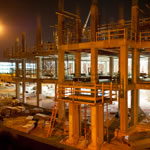Southern Illinois University Edwardsville (SIUE) has embarked on a major expansion effort to upgrade many of its campus facilities. In doing so, the school has turned to LEED construction principles to reduce its environmental impact. By the time all projects are complete, six campus facilities will be LEED Silver or higher, the second highest total among all Illinois universities. “It was a concerted effort that started out one project at a time,” says Rich Walker, assistant vice chancellor of administration at SIUE, which is less than 20 miles from St. Louis in Edwardsville, Illinois. “It continues to evolve into something more.”
In today’s competitive field of higher education, universities must find a way to deliver the amenities that prospective students want without significantly increasing their tuition costs, and an increasing awareness of environmental issues by SIUE constituents also have influenced decisions on new construction and renovation projects on campus. “Students are interested in doing the right thing, but they don’t want to pay more to go to school,” Walker says, who adds that SIUE has already reaped financial benefits from its efforts. “It really is paying off dividends in terms of utility bills.”
One major project expected to achieve LEED Silver is the Science Building Complex, which will be completed in two phases. The first is the new construction of the building that will house labs and offices for the chemistry, biology, and environmental sciences programs. The second phase, which has not yet begun construction, involves renovations to an existing building that will be home to the school’s math, statistics, and physics departments.

“Since we’ve started these building projects, awareness has increased throughout the university.”
Rich Walker, Southern Illinois University Edwardsville
After the project is complete, the two buildings will be connected via a sky bridge. “We are intentionally using similar strategies in the new building and the existing building,” Walker says. “We don’t want anybody to feel left behind.”
Some of the noteworthy eco-friendly features include a 1,100-square-foot green roof, which will double as an educational tool for biology faculty, and a 30-kilowatt photovoltaic array featuring panels from Lifeline Energy. Seventy-five percent of construction waste is being diverted from landfills, and 10 percent of materials used for the project have been sourced locally. The new building will also have an energy dashboard prominently displayed in the lobby. “It’s really a learning opportunity more than anything,” Walker says. “It helps to make students aware of the energy the building is using.” The new building will get rid of the old single-pane windows in favor of newer models.
At first, it was difficult for the building users to adjust to the lighting’s automatic sensors because they can shut off when a classroom is filled but has little activity. The university also struggled to attain LEED standards because its local contractors had limited experience in the area, and many of those contractors had to hire LEED consultants as a result.
But the projects have been worth its challenges, Walker says. SIUE has found room for improvement in testing envelope components to ensure they are achieving desired outcomes. “We’re finding some good results in that we are identifying problems during construction rather than later,” Walker says.
The biggest benefit of SIUE’s LEED projects has been the eco-conscious campus mentality. “Since we’ve started these building projects, awareness has increased throughout the university,” Walker says. SIUE has hired a campus sustainability officer, and students have formed an advisory group on efficiency issues, ensuring that sustainable building will continue on campus.

